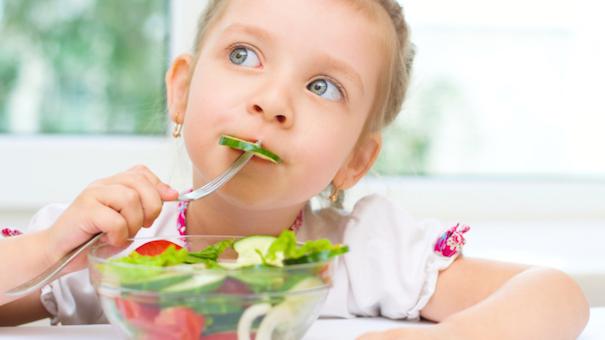Getting kids to eat more healthy foods is usually a top concern among moms today. There are so many unhealthy options available at the grocery store, at restaurants and eateries, and in the school cafeterias that it seems moms must work extra hard to make sure healthy foods don’t disappear from the menu. This becomes especially important when we take a look at some of the health problems facing young kids today that are increasingly being associated with poor diet such as diabetes, childhood obesity, attention deficit disorders, and even plaque build-up in the arteries.
What can you do when your kids just don’t prefer healthier foods and vegetables? Giving up and letting them eat whatever they want is not an option. Almost daily a mom tells me that I should just give up and give in and let my kids eat what everyone else is eating… so they can learn how to “cope” with the real world. I’m wondering if that also means I should just let them take some drugs and watch some ‘mature’, graphic entertainment, since that seems to be the way of the world, too!! Of course not! Giving up is absolutely not an option.
It’s time to get creative and here are some ideas.
1) Kid-Friendly Understanding of Requirements for Health
First and foremost, we teach our kids that vegetables are a requirement for health. Plain and simple, like it or not. If they want to feel great, be fast and strong, jump high, do well in school, etc. they need to include vegetables in their daily intake. It keeps them alive and well and their bodies performing at peak levels. I’m a firm believer in parents “wearing the nutritional pants” of the family. We set the rules for our kids when it comes to bedtime, chores, manners, time on the phone and computer, types of friends they can spend time with, experimenting with drugs and sex… why on earth would we not take food as seriously? It’s our job to keep our kids healthy and to teach them how to make healthy decisions for themselves. Wear the pants!
2) Get Sneaky
If you’re not up for wearing those very unpopular pants some days, one of the easiest ways to overcome an aversion to vegetables is to hide them inside other foods so that your kids either do not know they are there or they don’t care. This subject has come under fire recently with the release of two recipe books that address this very issue. The Sneaky Chef and Deceptively Delicious are two books that provide instruction on creating vegetable purees and then inserting them within other foods so that kids still get the nutritional benefit of their vegetables while still enjoying the “taste” of their favorite foods. The purees can be used in making macaroni and cheese, chicken nuggets, pizza, and even brownies.
Some parents have denounced this method saying that sneaking the vegetables into the meal does not effectively teach kids the importance of eating healthfully. Other parents have decided the benefits circumvent this reasoning and do not see why healthy eating education cannot include teaching children to disguise the healthy foods they find unappealing inside the foods they do like, perhaps creating a life long habit.
OK, I definitely agree with the first group of parents. To the second group I say, “Okaaaayyyy… I kinda’ sorta’ agree with you… kinda’!” I think kids need to completely understand the critical importance of filling up with healthy food choices, whether they need to disguise them or not. Once they understand THAT, I’m in favor of doing whatever floats your boat to get kids to consume generous amounts of veggies.
Some of the not-so-obvious ways we include ample servings of veggies (and other health-building foods) in our family’s diet can be summed up by the “3 S’s”: Soups, salads and smoothies. Especially at this time of year, we love to whip up a batch of homemade soup each week, loaded with a surplus of vegetables the kids might not consume otherwise. We also make a salad topping consisting of finely chopped pieces of a wide variety of vegetables – things like beets, kale, rutabaga, parsnip, leeks, onions – things you definitely won’t catch my kids asking for as a snack! We add various herbs and seeds, keep it all in a glass container in the fridge and scoop it onto whatever lettuce we’re using as a base. This ensures that we all get a wide variety of nutritious veggies at one sitting. Finally, we whip up a mean, green smoothie that our kids LOVE! (You can actually get FREE samples of the greens and protein we use at http://www.FirstShake.com/4251)
3) Invite Your Children to Participate in Meal Preparation
One of the best ways to ensure that kids are enthusiastic about their meal is to have them participate in making it. When they help out with meal preparation and cooking they feel a great sense of accomplishment and that in itself makes the meal more appealing. Even younger kids can help out by measuring or mixing ingredients, finding recipes inside magazines or cookbooks, and setting the table. The excitement of making the food can only be surpassed by the excitement of actually trying it. Just take a few deep breaths before undertaking this adventure with them… and anticipate that a normal 30 minute meal prep will now take 90 minutes, with their “help”!
4) Give Them Time
It can take many repeated exposures to vegetables at dinner time before kids feel comfortable trying them. The key is not to pressure them and make the dinner hour one of tension. Pressuring kids to eat their vegetables can work against our ultimate goal. Just keep serving vegetables and other healthy foods with each meal and let children get used to seeing them on their plates and their parents plates and often times they will come to accept them in time. If there are a select few veggies that your kids DO like, just make sure they get those daily. Right now our daughter is going though one of her phases where she’s not wanting much variety in her vegetable. I find myself serving her green beans, peas, carrots, cucumbers and tomatoes (I know it’s not really a vegetable!) for 80% of her dinners and lunches. Then I throw in asparagus, edamame beans, sweet potatoes and salads the other 20% of the time and don’t worry about it too much! I’m sure she’ll embrace broccoli and Brussels sprouts again at some point in her life!
Also, remember that children mimic the actions of their parents so the next time the salad is passed to you, realize that a big “I LOVE salad” can go a long way!




